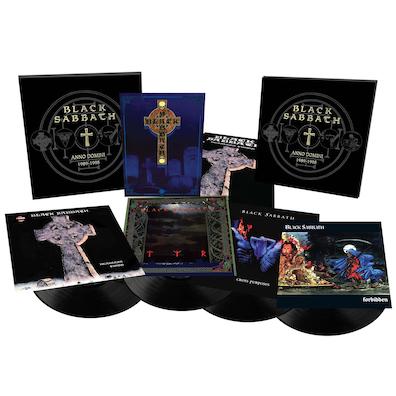
Black Sabbath
Anno Domini 1989-1995
Rhino
Jul 01, 2024
Web Exclusive
![]()
You have to commend Tony Iommi for soldiering on with the Black Sabbath name after so many changes in vocal personnel. Clearly, the original Sabbath, comprised of Iommi, Ozzy Osbourne, Geezer Butler, and Bill Ward, are epic progenitors of everything hard rock and heavy metal that would follow. And the Ronnie James Dio era of the early ’80s was nearly as successful, both in musical and popular terms. But after Dio left Black Sabbath in 1983, things took a bit of a turn, Iommi languoring for a few years without any permanent fixture at the vocal position. Until 1987, when Tony Martin joined the fold.
Unlike some of the earlier Sabbath vocalist retreads, Martin was new—a new face, a new voice, and a new lyricist—who would go on to release five albums with the band from the late-’80s through the mid-’90s. It is this often neglected era of Black Sabbath that is explored with Anno Domini, a lavish box set featuring the four Martin-era Sabbath albums (excepting 1987’s Eternal Idol, for which Martin joined midway through), along with a beautiful book featuring an oral history of the time as well as various ephemera, a giant poster, and a replica tour program.
A cynic’s view would be that the Tony Martin era of Black Sabbath is largely neglected for a reason—the music just wasn’t up to snuff, especially for a band of Black Sabbath’s history. And a cynic would be largely correct. Plus, releasing a Norse mythology-themed album the year before Nirvana dropped Nevermind was probably not a great foreshadower of things to come.
After 1989’s Headless Cross and the aforementioned Norse-themed Tyr from 1990, Geezer Butler was back in the fold for 1994’s Cross Purposes. Perhaps due to this and perhaps due to the album being the first after the short-lived reunion with Butler and Dio for the Dehumanizer album two years prior, Cross Purposes is more reminiscent of classic Sabbath. Iommi sounds more inspired than he had on Headless Cross and Tyr, and Martin’s vocals are less histrionic. Tempos seems slower, the overall tone sludgier. Of the four albums here, Cross Purposes is the keeper.
Forbidden, on the other hand, has not redeemed itself much with time. Excoriated upon its release, the 1995 album, Black Sabbath’s last before reuniting with its original Ozzy Osbourne-led lineup, found Iommi and company pairing with Body Count’s Ernie C and Ice-T in an attempt to modernize its sound. The result is a mishmash of songs that don’t work and certainly doesn’t sound like Sabbath. Unhappy with Ernie C’s original mix, Iommi remixed the album for this set, but it can’t fix the fact that the songs just largely aren’t there. Although, side B goes some way toward redeeming the album, Forbidden is the furthest from a real Sabbath album that the band would record.
Ultimately, Rhino Records, as usual, does a bang up job with the packaging of this set. Say what you will about the music herein, Anno Domini makes the Tony Martin era of Black Sabbath neglected no more. (www.rhino.com)
Author rating: 7/10
Current Issue

Issue #72
Apr 19, 2024 Issue #72 - The ‘90s Issue with The Cardigans and Thurston Moore
Most Recent
- Rosie Lowe Announces New Album and Shares Video for New Song “In My Head” (News) —
- Thala Shares Video for New Song “don’t want u to die” (News) —
- Premiere: New Gaze Shares New Video for “Dystopian Days” (News) —
- Janelle Monáe @ Factory International’s Aviva Studios, Manchester, UK, July 2, 2024 (Review) —
- Mercury Rev Share New Song “Ancient Love” (News) —

Comments
Submit your comment
There are no comments for this entry yet.